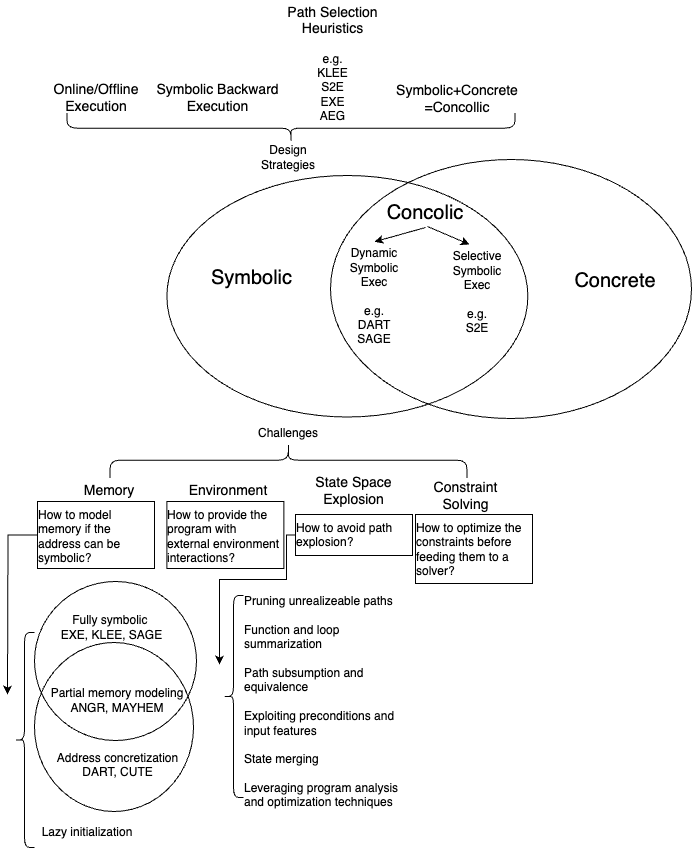Symbolic Execution Paper Collections
This blog presents a growing collection of papers and tools related to the topic of symbolic execution. I (hopefully ;p) plan to update it regularly, since I want it to serve as a handy index whenever I revisit this topic.
For each paper or tool listed here, I’ll include a link to a separate page with my notes from reading or studying it. The notes are definitely not complete, but I do aim for them to be sound (hopefully!).
I collected the related papers by refering to the following surveys/summaries:
- A Survey of Symbolic Execution Techniques, Baldoni et al. [link]
- Symbolic execution for software testing: Three decades later, Cadar et al. [link]
List of Paper Notes
Surveys
- Symbolic execution for software testing: Three decades later(2013)
- A Survey of Symbolic Execution Techniques(2018)
Classical Ones
- DART: directed automated random testing(2005)
- CUTE: A Concolic Unit Testing Engine for C(2005)
- EXE: Automatically Generating Inputs of Death(2006)
- KLEE: Unassisted and Automatic Generation of High-Coverage Tests for Complex Systems Programs(2008)
Modern Ones
- QSYM: a practical concolic execution engine tailored for hybrid fuzzing(2018)
- Symbolic execution with SymCC: Don’t interpret, compile!(2020)
- Coyote C++: An Industrial-Strength Fully Automated Unit Testing Tool(2023)
High-Level View
After skimming the survey A Survey of Symbolic Execution Techniques, I summarized the topics related to symbolic execution as the diagram below.

Symbolic Execution Tools Overview in 2013 Survey
When skimming the survey Symbolic execution for software testing: Three decades later I came accross a section named “Tools” which listed many symbolic execution tools with a brief introduction. I summarized them as below:
- DART: The first concolic testing tool that combines dynamic test generation with random testing and model checking techniques with the goal of systematically executing as many as possible execution paths of a program. DART was first implemented at Bell Labs for testing C programs, and has inspired many other extensions and tools since.
- CUTE: Extends DART to handle multithreaded programs that manipulate dynamic data structures using pointer operations. Developed at UIUC for C and Java programs (jCUTE is dedicated to Java).
- CREST: An open-source tool for concolic testing of C programs. It is an extensible platform for building and experimenting with heuristics for selecting which paths to explore.
- EXE: A symbolic execution tool for C programs designed for comprehensively testing complex software, with an empasis on systems code. EXE models memory with bit-level accuracy. EXE provides the speed necessary to quickly solve the constraints generated by real code, through a combination of low-level optimizations implemented in its purposely designed constraint solver STP, and a series of higher-level ones such as caching and irrelevant constraint elimination.
- KLEE: A redesign of EXE, built on top of the LLVM-compiler infrastructure. It performs concolic execution, models memory with bit-level accuracy, employs a variety of solving optimizations, and uses search heuristics to get high code coverage. one of the key improvements of KLEE over EXE is its ability to store a much larger number of concurrent states, by exploiting sharing among states at the object-level rahter than at the page-level. KLEE also has better environment interaction than EXE.
- SAGE: A dynamic symbolic execution tool developed by Microsoft for x86 binaries.
Advanced Directions by 2018 Survey
A Survey of Symbolic Execution Techniques was published in 2018. In the survey, some further directions for symbolic execution were listed. Below is a summarized version.
- Separation Logic: SL extends Hoare logic to facilitate reasoning about programs that maniputlate pointer data structures, and allows expressing compplex invariants of heap configurations in a succinct manner.
- Invariants: Leveraging invariants of loops can be beneficial to symbolic executors, there was no relavent work discoverd by the authors of the survey.
- Function Summaries: Calysto static checker is an example of using the call graph to construct a symbolic representation of effects on each function.
- Program Analysis and Optimization: The developments in programming languages realm could be beneficial to symbolic execution. Some examples are loop coalescing, loop unfolding, program synthesis.
- Symbolic Computation: Only Z3 and SMT-RAT can reason about non-linear real and integer arithmetic. The developments in symbolic computation can be used to help SMT solvers. SC^2 is an interesting project aiming to bridge the gap between symbolic computation and satisfiability checking.
Notes
For a graduate-level course I took in Spring 2025 at UIUC, I wrote a very preliminary review of some papers on this topic. I include that paper review here for future reference. pdf

